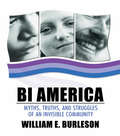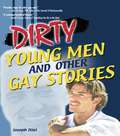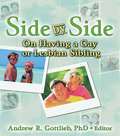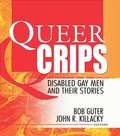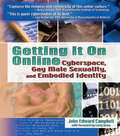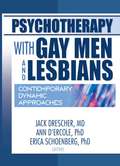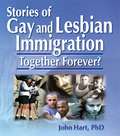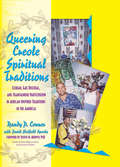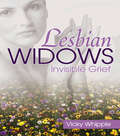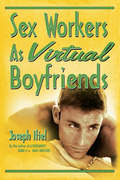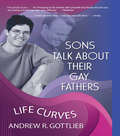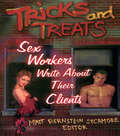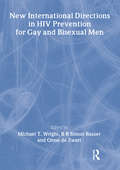- Table View
- List View
Bi America: Myths, Truths, and Struggles of an Invisible Community
by William BurlesonGain an in-depth understanding of the unique struggles of the bisexual community! "To me the gay and straight worlds are exactly the same; equally limited, judgmental, and bourgeois . . . just mirror images of each other. I truly like and overlap with some of the gay world, but my roots refuse to take hold there and grow. Unfortunately, my well-established roots in the straight world are simultaneously shriveling and dying too, leaving me feeling extremely unstable." -"Cool," a bisexual woman involved in a support groupThere are at least five million bisexual people in America, generally invisible to straight society, the gay community, and even to each other. While the vast majority of these five million live within the straight or gay world, there are a few who have formed a community of their own. Bi America: Myths, Truths, and Struggles of an Invisible Community offers an inside look at the American bisexual community and gives an understanding of the special circumstances unique to being bisexual. The book takes the reader to bi community events from picnics, to conferences, to support groups, to performances in order to expose the everyday trials of the bisexual community.Bi America includes very personal stories that let the voice of everyday bisexuals be heard through interviews, the "Bisexual History Project," in which ten bisexual people tell their life stories, and the "Online Support Group," a group of about 75 people who meet in cyberspace to talk about their lives and challenges. The book also includes the findings of a 2002 survey of about 300 bisexual people conducted via the Internet, an appendix that offers a concise list of resources for further study and personal enrichment, and an unabridged transcript of the "Bisexual History Project."Get the answers to these questions in Bi America: What is bisexuality? Is there a bisexual community? What is the culture of the bisexual community? What are commonalities and differences between the experiences of bi men and bi women? What is the special relationship between the bisexual and the transgender community? How have bisexuals and the bi community been affected by HIV/AIDS? What is the future of bisexual activism, if any? and many more! Bi America is a fascinating resource that exposes the challenges, struggles, and triumphs of bisexuals in America. Bisexuals, especially those newly coming out, can use this book to help understand their identity, and family members and friends seeking some insight into the unique circumstances faced by their loved ones will also find it helpful. This book will interest those concerned with the sociology of deviance or with subcultures in general. It is also appropriate for undergraduate sociology and cultural anthropology, as well as feminist studies and LGBT studies classes. This book offers one of the few accessible, nonacademic looks at this unique and interesting community. Visit the book's Web site at http://www.bi101.org
Dirty Young Men and Other Gay Stories
by Joseph ItielCome on a journey of erotic discovery where young guys seek out old gentlemen! It is well known that to most gay men, a shapely, youthful body is the ultimate turn-on. But a few young guys, sometimes even married ones, are erotically attracted to old men, because of their age. Joseph Itiel (author of Escort Tales; A Consumer&’s Guide to Male Hustlers; and Sex Workers as Virtual Boyfriends), now in his early seventies, has discovered such young fellows. In Dirty Young Men and Other Gay Stories, he relates his experiences with them in intimate detail. Dirty Young Men and Other Gay Stories is packed full of true younger-loves-older stories from all walks of life and from different countries. From the author: "It took me until my middle fifties to become a sex object. Before reaching this age, nobody had ever been infatuated with my looks or physique. I hadn&’t been selected out of a crowd just because someone thought I would be a good lay. Wouldn&’t it be nice, I kept hoping, if for once I would fulfill somebody&’s sexual fantasies, and be picked for just this reason? Well, at the age of fifty-five, my daydreams started to become a reality. Finally, I became a sex object, a &’man toy,&’ to cute guys much younger than myself." Dirty Young Men and Other Gay Stories is packed full of erotic true stories from the author&’s real life experience. Here is a sample of what you&’ll find: "Master of the Dildo"-the fulfillment of a young man&’s desire for penetration by a man old enough to be his father, notwithstanding his young (female) sweetheart "Bligh&’s Bounty"-the adventures of an older man in San Francisco&’s first gay go-go bar "The Hypnotic Suggestion"-an older "straight" man seeks to discover his true identity by exploring, through hypnosis, a fleeting gay moment in his past "An Affair in the Galilee Mountains"-a bittersweet love affair between a "professor" and a younger, uneducated local man "The Dominatrix"-the author befriends (and beds) a much younger man who, it turns out, makes his living as a cross-dressing dominatrix, administering beatings to "straight" men for money "Teaching a Man to Fish"-the author teaches two attractive young men the art of escorting From Galilee to Lisbon to San Francisco, Joseph Itiel&’s Dirty Young Men and Other Gay Stories will take you on an erotic journey that you won&’t soon forget!
Dirty Young Men and Other Gay Stories
by Joseph ItielCome on a journey of erotic discovery where young guys seek out old gentlemen! It is well known that to most gay men, a shapely, youthful body is the ultimate turn-on. But a few young guys, sometimes even married ones, are erotically attracted to old men, because of their age. Joseph Itiel (author of Escort Tales; A Consumer&’s Guide to Male Hustlers; and Sex Workers as Virtual Boyfriends), now in his early seventies, has discovered such young fellows. In Dirty Young Men and Other Gay Stories, he relates his experiences with them in intimate detail. Dirty Young Men and Other Gay Stories is packed full of true younger-loves-older stories from all walks of life and from different countries. From the author: "It took me until my middle fifties to become a sex object. Before reaching this age, nobody had ever been infatuated with my looks or physique. I hadn&’t been selected out of a crowd just because someone thought I would be a good lay. Wouldn&’t it be nice, I kept hoping, if for once I would fulfill somebody&’s sexual fantasies, and be picked for just this reason? Well, at the age of fifty-five, my daydreams started to become a reality. Finally, I became a sex object, a &’man toy,&’ to cute guys much younger than myself." Dirty Young Men and Other Gay Stories is packed full of erotic true stories from the author&’s real life experience. Here is a sample of what you&’ll find: "Master of the Dildo"-the fulfillment of a young man&’s desire for penetration by a man old enough to be his father, notwithstanding his young (female) sweetheart "Bligh&’s Bounty"-the adventures of an older man in San Francisco&’s first gay go-go bar "The Hypnotic Suggestion"-an older "straight" man seeks to discover his true identity by exploring, through hypnosis, a fleeting gay moment in his past "An Affair in the Galilee Mountains"-a bittersweet love affair between a "professor" and a younger, uneducated local man "The Dominatrix"-the author befriends (and beds) a much younger man who, it turns out, makes his living as a cross-dressing dominatrix, administering beatings to "straight" men for money "Teaching a Man to Fish"-the author teaches two attractive young men the art of escorting From Galilee to Lisbon to San Francisco, Joseph Itiel&’s Dirty Young Men and Other Gay Stories will take you on an erotic journey that you won&’t soon forget!
Side by Side: On Having a Gay or Lesbian Sibling
by Andrew R. GottliebHow would you react if your brother or sister came out to you? "I'm proud to have been the first to know." "My conservative upbringing contributed to the notion that John&’s behavior was sinful. The first thought I had about it was that my brother had somehow been misdirected, involving himself in the wrong crowd. How could he be gay? I was convinced we all had to help him overcome this problem. I equated being gay with having a mental disorder and thought maybe we should send him to a therapist." "I love Beth very much. I am proud of her, thankful for her, and can&’t imagine life without her." In this first-of-its-kind book, Andrew Gottlieb, the author of Out of the Twilight: Fathers of Gay Men Speak and Sons Talk About Their Gay Fathers: Life Curves, continues his landmark exploration at the intersection of sexuality and family studies. Here he turns his thoughtful gaze to the powerful bonds of brotherhood and sisterhood to address questions such as: How are we affected by the knowledge that a sibling feels same-sex attraction, and how does that knowledge impact on our relationships with our brother or sister? How do brothers and sisters of gay/lesbian people cope with stigma and homophobia? What if there&’s already a non-heterosexual sibling in the family-how does he or she react when another sibling comes out? Do each of their roles change? "Besides the fact that Lee didn&’t conform to my notion of what a lesbian was (I, of course, always looked and acted the part), I wondered how this would affect my role as &’the lesbian of the family.&’ . . . Would this rock the boat? Would two lesbians in the family be one lesbian too many?" In their own words, 18 men and women share their thoughts and feelings about their gay brothers and sisters. What they have to say is revealing-about themselves, about the nature of sibling relationships, and about their role as peacemakers. Gay men and lesbian women often disclose their sexuality to their siblings before anyone else in their families. Side by Side examines the impact of a brother or sister coming out and of the way that a gay person&’s siblings are sometimes placed in the position of being a social/moral bridge between the generations. "Clearly Tina has been a major force in my life, and it doesn&’t just end with me. My three children and husband have all learned by Tina&’s example; we all do what we can to bring fairness and equality to everyone. With a smile on my face, I occasionally say to Tina, &’Look what you&’ve done to me!&’ Without her, I would never be where I am or who I am." The contributors to Side by Side come from varying religious and economic backgrounds. In plain language that is easily accessible to most adolescents and adults, they candidly relate the experience of what it was like to find out about their sibling&’s homosexuality and how that knowledge affected them over time. Some of their perspectives may surprise you. Many will move you. You&’ll also find a list of suggested readings and a list of organizations offering support and information for siblings of gay, lesbian, bisexual, and transgender people.
Side by Side: On Having a Gay or Lesbian Sibling
by Andrew GottliebHow would you react if your brother or sister came out to you? "I'm proud to have been the first to know." "My conservative upbringing contributed to the notion that John&’s behavior was sinful. The first thought I had about it was that my brother had somehow been misdirected, involving himself in the wrong crowd. How could he be gay? I was convinced we all had to help him overcome this problem. I equated being gay with having a mental disorder and thought maybe we should send him to a therapist." "I love Beth very much. I am proud of her, thankful for her, and can&’t imagine life without her." In this first-of-its-kind book, Andrew Gottlieb, the author of Out of the Twilight: Fathers of Gay Men Speak and Sons Talk About Their Gay Fathers: Life Curves, continues his landmark exploration at the intersection of sexuality and family studies. Here he turns his thoughtful gaze to the powerful bonds of brotherhood and sisterhood to address questions such as: How are we affected by the knowledge that a sibling feels same-sex attraction, and how does that knowledge impact on our relationships with our brother or sister? How do brothers and sisters of gay/lesbian people cope with stigma and homophobia? What if there&’s already a non-heterosexual sibling in the family-how does he or she react when another sibling comes out? Do each of their roles change? "Besides the fact that Lee didn&’t conform to my notion of what a lesbian was (I, of course, always looked and acted the part), I wondered how this would affect my role as &’the lesbian of the family.&’ . . . Would this rock the boat? Would two lesbians in the family be one lesbian too many?" In their own words, 18 men and women share their thoughts and feelings about their gay brothers and sisters. What they have to say is revealing-about themselves, about the nature of sibling relationships, and about their role as peacemakers. Gay men and lesbian women often disclose their sexuality to their siblings before anyone else in their families. Side by Side examines the impact of a brother or sister coming out and of the way that a gay person&’s siblings are sometimes placed in the position of being a social/moral bridge between the generations. "Clearly Tina has been a major force in my life, and it doesn&’t just end with me. My three children and husband have all learned by Tina&’s example; we all do what we can to bring fairness and equality to everyone. With a smile on my face, I occasionally say to Tina, &’Look what you&’ve done to me!&’ Without her, I would never be where I am or who I am." The contributors to Side by Side come from varying religious and economic backgrounds. In plain language that is easily accessible to most adolescents and adults, they candidly relate the experience of what it was like to find out about their sibling&’s homosexuality and how that knowledge affected them over time. Some of their perspectives may surprise you. Many will move you. You&’ll also find a list of suggested readings and a list of organizations offering support and information for siblings of gay, lesbian, bisexual, and transgender people.
Queer Crips: Disabled Gay Men and Their Stories
by Bob Guter John R KillackyGet an inside perspective on life as a disabled gay man! Queer Crips: Disabled Gay Men and Their Stories reverberates with the sound of "cripgay" voices rising to be heard above the din of indifference and bias, oppression and ignorance. This unique collection of compelling first-person narratives is at once assertive, bold, and groundbreaking, filled with characters-and character. Through the intimacy of one-on-one storytelling, gay men with mobility and neuromuscular disorders, spinal cord injury, deafness, blindness, and AIDS, fight isolation from society-and each other-to establish a public identity and a common culture. Queer Crips features more than 30 first-hand accounts from a variety of perspectives, illuminating the reality of the everyday struggle disabled gay men face in a culture obsessed with conformist good looks. Themes include rejection, love, sex, dating rituals, gaycrip married life, and the profound difference between growing up queer and disabled, and suffering a life-altering injury or illness in adulthood. Co-edited by Bob Guter, creator and editor of the webzine BENT: A Journal of Cripgay Voices, the book includes: two performance pieces from acclaimed author and actor Greg Walloch poetry from Chris Hewitt, Joel S. Riche, Raymond Luczak, Mark Moody, and co-editor John Killacky essays from BENT contributors Blaine Waterman, Raymond J. Aguilera, Danny Kodmur, Thomas Metz, Max Verga, and Eli Clare interviews with community activist Gordon Elkins and Alan Sable, one of the first self-identified gay psychotherapists in the United States and much more! Queer Crips is a forum for neglected cripgay voices speaking words that are candid, edgy, bold, dreamy, challenging, and sexy. The book is essential reading for academics and students working in lesbian and gay studies, and disability studies, and for anyone who's ever visited the place where queerness and disability meet.
Queer Crips: Disabled Gay Men and Their Stories
by Bob Guter John R KillackyGet an inside perspective on life as a disabled gay man! Queer Crips: Disabled Gay Men and Their Stories reverberates with the sound of "cripgay" voices rising to be heard above the din of indifference and bias, oppression and ignorance. This unique collection of compelling first-person narratives is at once assertive, bold, and groundbreaking, filled with characters-and character. Through the intimacy of one-on-one storytelling, gay men with mobility and neuromuscular disorders, spinal cord injury, deafness, blindness, and AIDS, fight isolation from society-and each other-to establish a public identity and a common culture. Queer Crips features more than 30 first-hand accounts from a variety of perspectives, illuminating the reality of the everyday struggle disabled gay men face in a culture obsessed with conformist good looks. Themes include rejection, love, sex, dating rituals, gaycrip married life, and the profound difference between growing up queer and disabled, and suffering a life-altering injury or illness in adulthood. Co-edited by Bob Guter, creator and editor of the webzine BENT: A Journal of Cripgay Voices, the book includes: two performance pieces from acclaimed author and actor Greg Walloch poetry from Chris Hewitt, Joel S. Riche, Raymond Luczak, Mark Moody, and co-editor John Killacky essays from BENT contributors Blaine Waterman, Raymond J. Aguilera, Danny Kodmur, Thomas Metz, Max Verga, and Eli Clare interviews with community activist Gordon Elkins and Alan Sable, one of the first self-identified gay psychotherapists in the United States and much more! Queer Crips is a forum for neglected cripgay voices speaking words that are candid, edgy, bold, dreamy, challenging, and sexy. The book is essential reading for academics and students working in lesbian and gay studies, and disability studies, and for anyone who's ever visited the place where queerness and disability meet.
Getting It On Online: Cyberspace, Gay Male Sexuality, and Embodied Identity
by John Edward CampbellLearn how gay men use Internet technologies to connect with others sharing their erotic desires and to forge affirming communities online! Getting It On Online: Cyberspace, Gay Male Sexuality, and Embodied Identity examines the online embodied experiences of gay men. At once scholarly and sensual, this unique book is the result of a three-year ethnographic study chronicling the activities on three distinct social scenes in the world of Internet Relay Chat (IRC)-virtual spaces constructed by gay men for the erotic exploration of the male body. Examining the vital role the body plays in defining these online spaces offers insight into how gay men negotiate their identities through emerging communication technologies. The author combines a critical look at the role of the body in cyberspace with candid accounts of his own online experiences to challenge conventional views on sex, sexuality, and embodied identity. Getting It On Online provides an inside look at three specific online communities-gaychub (a community celebrating male obesity), gaymuscle (a community formulated around images of the muscular male body), and gaymusclebears (a space representing the erotic convergence of the obese and muscular male bodies emerging out of the gay male "bear" subculture)-in an effort to unsettle those models of beauty and the erotic depicted in more mainstream media. The book demonstrates how the social position of these men in the physical world in regards to age, race, gender, class, and physical beauty influences their online experiences. Far from a realm of bodiless exultation, Getting It On Online illustrates how the flesh remains very much present in cyberspace. Getting It On Online examines topics such as: why people chat online the history of IRC (Internet Relay Chat) how people construct their identities in cyberspace how some online spaces function like virtual gay bars the concept of online disembodiment the role the body plays in online social relations the future of online communication ethnographic research in cyberspace mediated images of the male body and the gay male beauty myth and much more! Getting It On Online: Cyberspace, Gay Male Sexuality, and Embodied Identity is an essential resource for anthropologists, sociologists, and psychologists; academics working in gender studies, queer theory, cultural studies, and cyber-culture studies; and anyone interested in gay and lesbian issues and/or cyberspace.
Getting It On Online: Cyberspace, Gay Male Sexuality, and Embodied Identity
by John Edward CampbellLearn how gay men use Internet technologies to connect with others sharing their erotic desires and to forge affirming communities online! Getting It On Online: Cyberspace, Gay Male Sexuality, and Embodied Identity examines the online embodied experiences of gay men. At once scholarly and sensual, this unique book is the result of a three-year ethnographic study chronicling the activities on three distinct social scenes in the world of Internet Relay Chat (IRC)-virtual spaces constructed by gay men for the erotic exploration of the male body. Examining the vital role the body plays in defining these online spaces offers insight into how gay men negotiate their identities through emerging communication technologies. The author combines a critical look at the role of the body in cyberspace with candid accounts of his own online experiences to challenge conventional views on sex, sexuality, and embodied identity. Getting It On Online provides an inside look at three specific online communities-gaychub (a community celebrating male obesity), gaymuscle (a community formulated around images of the muscular male body), and gaymusclebears (a space representing the erotic convergence of the obese and muscular male bodies emerging out of the gay male "bear" subculture)-in an effort to unsettle those models of beauty and the erotic depicted in more mainstream media. The book demonstrates how the social position of these men in the physical world in regards to age, race, gender, class, and physical beauty influences their online experiences. Far from a realm of bodiless exultation, Getting It On Online illustrates how the flesh remains very much present in cyberspace. Getting It On Online examines topics such as: why people chat online the history of IRC (Internet Relay Chat) how people construct their identities in cyberspace how some online spaces function like virtual gay bars the concept of online disembodiment the role the body plays in online social relations the future of online communication ethnographic research in cyberspace mediated images of the male body and the gay male beauty myth and much more! Getting It On Online: Cyberspace, Gay Male Sexuality, and Embodied Identity is an essential resource for anthropologists, sociologists, and psychologists; academics working in gender studies, queer theory, cultural studies, and cyber-culture studies; and anyone interested in gay and lesbian issues and/or cyberspace.
Psychotherapy with Gay Men and Lesbians: Contemporary Dynamic Approaches
by Jack Drescher Ann D'Ercole Erica SchoenbergExamine gay and lesbian psychoanalysis from a variety of perspectives! Psychotherapy with Gay Men and Lesbians: Contemporary Dynamic Approaches presents case histories of psychotherapy sessions with gay and lesbian patients, focusing on today's psychoanalytical approaches. Dedicated to enhancing the emotional, psychological, and psychiatric treatment of gay men, lesbians, and bisexuals, the book features prominent analysts with a wide range of clinical and theoretical approaches. The foremost experts in the therapeutic field address issues affecting gay and lesbian patients from psychoanalytic perspectives that respect the patients' sexual identities. Psychotherapy with Gay Men and Lesbians reflects the significant clinical and theoretical changes therapists face in dealing with issues of gender and sexuality. New ways of thinking coexist with traditional theory as paradigm shifts in psychotherapy and psychoanalysis affect the treatment of gay, lesbian, and bisexual patients. This book provides a forum to address those changes through clinical papers and discussions. Psychotherapy with Gay Men and Lesbians includes discussion of case reports that deal with: gay therapists treating gay patients countertransferential enactments of sex and gender in treatment rethinking the meanings of homosexuality psychotherapeutic treatment of gay male patients with AIDS and much more! Psychotherapy with Gay Men and Lesbians is an essential forum for the exchange of clinical information on gay and lesbian psychotherapy. The book is a valuable resource for psychiatrists, psychologists, social work therapists, psychoanalysts, and anyone interested in today's psychoanalytic approaches to homosexuality.
Psychotherapy with Gay Men and Lesbians: Contemporary Dynamic Approaches
by Jack Drescher Ann D'Ercole Erica SchoenbergExamine gay and lesbian psychoanalysis from a variety of perspectives! Psychotherapy with Gay Men and Lesbians: Contemporary Dynamic Approaches presents case histories of psychotherapy sessions with gay and lesbian patients, focusing on today's psychoanalytical approaches. Dedicated to enhancing the emotional, psychological, and psychiatric treatment of gay men, lesbians, and bisexuals, the book features prominent analysts with a wide range of clinical and theoretical approaches. The foremost experts in the therapeutic field address issues affecting gay and lesbian patients from psychoanalytic perspectives that respect the patients' sexual identities. Psychotherapy with Gay Men and Lesbians reflects the significant clinical and theoretical changes therapists face in dealing with issues of gender and sexuality. New ways of thinking coexist with traditional theory as paradigm shifts in psychotherapy and psychoanalysis affect the treatment of gay, lesbian, and bisexual patients. This book provides a forum to address those changes through clinical papers and discussions. Psychotherapy with Gay Men and Lesbians includes discussion of case reports that deal with: gay therapists treating gay patients countertransferential enactments of sex and gender in treatment rethinking the meanings of homosexuality psychotherapeutic treatment of gay male patients with AIDS and much more! Psychotherapy with Gay Men and Lesbians is an essential forum for the exchange of clinical information on gay and lesbian psychotherapy. The book is a valuable resource for psychiatrists, psychologists, social work therapists, psychoanalysts, and anyone interested in today's psychoanalytic approaches to homosexuality.
Stories of Gay and Lesbian Immigration: Together Forever?
by John HartShare the personal stories of gay and lesbian couples who immigrated to Australia!This fascinating book examines the Australian government’s innovative immigration program for same-sex couples. Covering the time from the early 1980s to 2000, Stories of Gay and Lesbian Immigration: Together Forever? offers a powerful glimpse into the gains and costs of immigration. Its twenty-year span offers insight into both immediate and long-term implications of this policy.Stories of Gay and Lesbian Immigration intertwines the personal stories of gay and lesbian immigrants, including the author, with thoughtful, detailed political analysis. This groundbreaking book analyzes the Australian government’s reasons for recognizing the validity of same-sex couples. It also scrutinizes the emotional and social implications of government policies for these couples.Stories of Gay and Lesbian Immigration explores the issues immigrant same-sex couples faced, including: HIV/AIDS proving homosexuality migration stress dealing with bureaucracy financial dependency success and failure in relationshipsStories of Gay and Lesbian Immigration will be of interest to political scientists, historians of gay and lesbian culture, policymakers seeking to change immigration laws, and anyone interested in this aspect of gay and lesbian relationships.
Stories of Gay and Lesbian Immigration: Together Forever?
by John HartShare the personal stories of gay and lesbian couples who immigrated to Australia!This fascinating book examines the Australian government’s innovative immigration program for same-sex couples. Covering the time from the early 1980s to 2000, Stories of Gay and Lesbian Immigration: Together Forever? offers a powerful glimpse into the gains and costs of immigration. Its twenty-year span offers insight into both immediate and long-term implications of this policy.Stories of Gay and Lesbian Immigration intertwines the personal stories of gay and lesbian immigrants, including the author, with thoughtful, detailed political analysis. This groundbreaking book analyzes the Australian government’s reasons for recognizing the validity of same-sex couples. It also scrutinizes the emotional and social implications of government policies for these couples.Stories of Gay and Lesbian Immigration explores the issues immigrant same-sex couples faced, including: HIV/AIDS proving homosexuality migration stress dealing with bureaucracy financial dependency success and failure in relationshipsStories of Gay and Lesbian Immigration will be of interest to political scientists, historians of gay and lesbian culture, policymakers seeking to change immigration laws, and anyone interested in this aspect of gay and lesbian relationships.
Queering Creole Spiritual Traditions: Lesbian, Gay, Bisexual, and Transgender Participation in African-Inspired Traditions in the Americas
by Randy P Lundschien Conner David SparksWhat roles do queer and transgender people play in the African diasporic religions? Queering Creole Spiritual Traditions: Lesbian, Gay, Bisexual, and Transgender Participation in African-Inspired Traditions in the Americas is a groundbreaking scholarly exploration of this long-neglected subject. It offers clear insight into the complex dynamics of gender and sexual orientation, humans and deities, and race and ethnicity, within these richly nuanced spiritual practices. Queering Creole Spiritual Traditions explores the ways in which gender complexity and same-sex intimacy are integral to the primary beliefs and practices of these faiths. It begins with a comprehensive overview of Vodou, Santeria, and other African-based religions. The second section includes extensive, revealing interviews with practitioners who offer insight into the intersection of their beliefs, their sexual orientation, and their gender identity. Finally, it provides a powerful analysis of the ways these traditions have inspired artists, musicians, and writers such as Audre Lorde, as well as informative interviews with the artists themselves. In Queering Creole Spiritual Traditions, you will discover: how the presence of androgynous divinities affects both faith and practice in Vodou, Candomble, Santeria, and other Creole religions how the phenomenon of possession or embodiment by a god or goddess may validate queer identity and nurture gender complexity who practices the African-derived spiritual traditions, what they believe, and who their deities are how these faiths have influenced the art and aesthetic traditions of the West This landmark book opens a fascinating new world of thought and belief. The authors provide rigorous documentation and faultless scholarly method as well as personal experience and the testimony of believers. Queering Creole Spiritual Traditions sheds new light on two widely different fields: LGBT studies and the theology of the African diaspora. A thorough bibliography points the way to further study, and an extensive photograph gallery provides a unique look at the believers and their practices. Every library with holdings in queer theory, African mythology, or sociology of religion should have this landmark volume.
Queering Creole Spiritual Traditions: Lesbian, Gay, Bisexual, and Transgender Participation in African-Inspired Traditions in the Americas
by Randy P Lundschien Conner David SparksWhat roles do queer and transgender people play in the African diasporic religions? Queering Creole Spiritual Traditions: Lesbian, Gay, Bisexual, and Transgender Participation in African-Inspired Traditions in the Americas is a groundbreaking scholarly exploration of this long-neglected subject. It offers clear insight into the complex dynamics of gender and sexual orientation, humans and deities, and race and ethnicity, within these richly nuanced spiritual practices. Queering Creole Spiritual Traditions explores the ways in which gender complexity and same-sex intimacy are integral to the primary beliefs and practices of these faiths. It begins with a comprehensive overview of Vodou, Santeria, and other African-based religions. The second section includes extensive, revealing interviews with practitioners who offer insight into the intersection of their beliefs, their sexual orientation, and their gender identity. Finally, it provides a powerful analysis of the ways these traditions have inspired artists, musicians, and writers such as Audre Lorde, as well as informative interviews with the artists themselves. In Queering Creole Spiritual Traditions, you will discover: how the presence of androgynous divinities affects both faith and practice in Vodou, Candomble, Santeria, and other Creole religions how the phenomenon of possession or embodiment by a god or goddess may validate queer identity and nurture gender complexity who practices the African-derived spiritual traditions, what they believe, and who their deities are how these faiths have influenced the art and aesthetic traditions of the West This landmark book opens a fascinating new world of thought and belief. The authors provide rigorous documentation and faultless scholarly method as well as personal experience and the testimony of believers. Queering Creole Spiritual Traditions sheds new light on two widely different fields: LGBT studies and the theology of the African diaspora. A thorough bibliography points the way to further study, and an extensive photograph gallery provides a unique look at the believers and their practices. Every library with holdings in queer theory, African mythology, or sociology of religion should have this landmark volume.
Lesbian Widows: Invisible Grief
by Victoria WhippleThe unseen issues of grief and discrimination-lesbians becoming widows The death of a life partner poses unique challenges for lesbians. Lesbian Widows: Invisible Grief reveals the touching and very personal stories of twenty-five women, including the author, who were widowed at a young age and forced to create a new life without their life partners. The book follows the widows from the time the couple met, to the time when one of the partners died, and beyond, to show how the surviving partner coped with her loss.Many lesbians feel that the intimacy felt between two women in love goes deeper than what can be experienced by heterosexual partners. Lesbian Widows: Invisible Grief reveals themes common to all these women&’s experiences while offering practical advice about coping techniques and resources for support. The widows discuss their efforts to create funerals and memorial services, give their accounts of the overwhelming grief throughout the first two years, and explain the legal and financial discrimination they encountered. The author provides a chapter specifically for caring family and friends, another chapter for professionals working with this sensitive population, and a bibliography of helpful coping resources.Lesbian Widows: Invisible Grief explores the topics of: caregivers/caretaking death and dying grief journeys the similarities and differences between lesbian and married widows the lack of support services for lesbian widows the legal and financial discrimination against lesbian widows the effect of being "in" or "out" on grief recovery the issues faced by widows in starting new relationships spirituality gay marriageLesbian Widows: Invisible Grief provides an insightful look into the grieving and recovery process, inspiring hope with the knowledge that others have survived this tragedy. This moving book is an essential resource for lesbians, friends and family of lesbians, mental health professionals, medical professionals, psychiatrists, LGBT health providers, feminist and lesbian organizations, and anyone involved with grief training programs such as hospice.
Lesbian Widows: Invisible Grief
by Victoria WhippleThe unseen issues of grief and discrimination-lesbians becoming widows The death of a life partner poses unique challenges for lesbians. Lesbian Widows: Invisible Grief reveals the touching and very personal stories of twenty-five women, including the author, who were widowed at a young age and forced to create a new life without their life partners. The book follows the widows from the time the couple met, to the time when one of the partners died, and beyond, to show how the surviving partner coped with her loss.Many lesbians feel that the intimacy felt between two women in love goes deeper than what can be experienced by heterosexual partners. Lesbian Widows: Invisible Grief reveals themes common to all these women&’s experiences while offering practical advice about coping techniques and resources for support. The widows discuss their efforts to create funerals and memorial services, give their accounts of the overwhelming grief throughout the first two years, and explain the legal and financial discrimination they encountered. The author provides a chapter specifically for caring family and friends, another chapter for professionals working with this sensitive population, and a bibliography of helpful coping resources.Lesbian Widows: Invisible Grief explores the topics of: caregivers/caretaking death and dying grief journeys the similarities and differences between lesbian and married widows the lack of support services for lesbian widows the legal and financial discrimination against lesbian widows the effect of being "in" or "out" on grief recovery the issues faced by widows in starting new relationships spirituality gay marriageLesbian Widows: Invisible Grief provides an insightful look into the grieving and recovery process, inspiring hope with the knowledge that others have survived this tragedy. This moving book is an essential resource for lesbians, friends and family of lesbians, mental health professionals, medical professionals, psychiatrists, LGBT health providers, feminist and lesbian organizations, and anyone involved with grief training programs such as hospice.
Sex Workers As Virtual Boyfriends
by Joseph ItielBeyond lust, create companionship with your sex workers!Many more men are willing to buy sex than to admit the fact. Joseph Itiel is not only willing to admit it--he has the courage and style to create “virtual” relationships with hustlers. These ongoing professional relationships are a step beyond cold, anonymous sex for sale. Though the economic basis remains the same--an open exchange of cash for sex--the association is also honest, affectionate, and sexually fulfilling. He explains how you can do the same in Sex Workers as Virtual Boyfriends, a companion volume to his best-selling A Consumer's Guide to Male Hustlers (Haworth 1998).From his own experience, stretching over four decades and many nations, the author suggests ways to transform the relationship between a client and his escort from a crass commercial transaction to a true camaraderie. Sex Workers as Virtual Boyfriends also offers an intimate glimpse into the gay lifestyle in San Francisco and around the world before the AIDS epidemic and in these days of safer sex. Sex Workers as Virtual Boyfriends presents practical tips and real-life vignettes, including: an experiment to help you decide if you could be a sex worker (See if you measure up!) an appendix containing a comprehensive list of sex workers advertising on the World Wide Web seven guidelines for friendly relations with your escort a guide to the etiquette of negotiable affectionSex Workers as Virtual Boyfriends is shocking, sexy, literate, and fun. It also can help you find the affection you want--at a price you can afford.
Sex Workers As Virtual Boyfriends
by Joseph ItielBeyond lust, create companionship with your sex workers!Many more men are willing to buy sex than to admit the fact. Joseph Itiel is not only willing to admit it--he has the courage and style to create “virtual” relationships with hustlers. These ongoing professional relationships are a step beyond cold, anonymous sex for sale. Though the economic basis remains the same--an open exchange of cash for sex--the association is also honest, affectionate, and sexually fulfilling. He explains how you can do the same in Sex Workers as Virtual Boyfriends, a companion volume to his best-selling A Consumer's Guide to Male Hustlers (Haworth 1998).From his own experience, stretching over four decades and many nations, the author suggests ways to transform the relationship between a client and his escort from a crass commercial transaction to a true camaraderie. Sex Workers as Virtual Boyfriends also offers an intimate glimpse into the gay lifestyle in San Francisco and around the world before the AIDS epidemic and in these days of safer sex. Sex Workers as Virtual Boyfriends presents practical tips and real-life vignettes, including: an experiment to help you decide if you could be a sex worker (See if you measure up!) an appendix containing a comprehensive list of sex workers advertising on the World Wide Web seven guidelines for friendly relations with your escort a guide to the etiquette of negotiable affectionSex Workers as Virtual Boyfriends is shocking, sexy, literate, and fun. It also can help you find the affection you want--at a price you can afford.
Sons Talk About Their Gay Fathers: Life Curves
by Andrew GottliebExamine the impact of disclosure on sons whose fathers are gay! In this book, Andrew Gottlieb, author of Out of the Twilight: Fathers of Gay Men Speak, explores yet another side of the impact of homosexuality on families. He now looks at how sons react to learning that their fathers are gay, allowing us to see, over time, how this has changed their family relationships and their own lives. Simply and elegantly written, this psychoanalytically oriented qualitative research study is accessible to both the beginner and the more advanced researcher and practitioner. It draws from a wide range of literary, popular, and psychological sources and includes an interview guide, a reference section, and an index. "When someone discloses as gay, lesbian, or bisexual, it is not just an individual event. It is a family event. Based on estimates of married gay, lesbian, and bisexual persons, a spouse's coming out affects up to 2,000,000 couples. Yet, its impact has been largely ignored. Children&’s voices are the least often heard. . . . Little has been written about sons of fathers who came out during or after marriage. Data for studies that do exist most often draw from the fathers' point of view. . . . The significance of this study lies in its comprehensive, detailed picture of sons and gay fathers as they develop their separate self-images as well as the images of their son-father relationships over time. Painful, sensitive, often triumphant, the stories and [the author&’s] analysis of their thoughts, perceptions, and feelings afford a multidimensional, longitudinal viewing. Step by step, we follow the complicated dance of these sons and fathers as they develop and define their connection." -from the Foreword by Amity Pierce Buxton, Author of The Other Side of the Closet: The Coming-Out Crisis for Straight Spouses and Families Sons Talk About Their Gay Fathers: Life Curves is a storybook-an extended narrative moved along, but not overshadowed, by psychoanalytic theory. The Introduction briefly reviews more recent writings of the fathering experience as told by gay men themselves, setting the stage for: "Father to Child"-a look at the father as seen through the ever-shifting eyes of his son at different phases of the life cycle "The Quest for the Real Father"-an examination of sons' responses to their fathers' homosexuality as captured in film, fiction, nonfiction, television, and the psychological literature "Methodology"-the story of the research process, including sampling, the search for subjects, trustworthiness, the interview, bias, and data collection "The Stories"-an anthology of narratives the author constructed from the interview material, painting an intimate portrait of each individual son "Findings"-a categorical analysis "Discussion"-a summary of all the preceding material cast in a developmental framework, highlighting implications for future research and clinical practice
Sons Talk About Their Gay Fathers: Life Curves
by Andrew GottliebExamine the impact of disclosure on sons whose fathers are gay! In this book, Andrew Gottlieb, author of Out of the Twilight: Fathers of Gay Men Speak, explores yet another side of the impact of homosexuality on families. He now looks at how sons react to learning that their fathers are gay, allowing us to see, over time, how this has changed their family relationships and their own lives. Simply and elegantly written, this psychoanalytically oriented qualitative research study is accessible to both the beginner and the more advanced researcher and practitioner. It draws from a wide range of literary, popular, and psychological sources and includes an interview guide, a reference section, and an index. "When someone discloses as gay, lesbian, or bisexual, it is not just an individual event. It is a family event. Based on estimates of married gay, lesbian, and bisexual persons, a spouse's coming out affects up to 2,000,000 couples. Yet, its impact has been largely ignored. Children&’s voices are the least often heard. . . . Little has been written about sons of fathers who came out during or after marriage. Data for studies that do exist most often draw from the fathers' point of view. . . . The significance of this study lies in its comprehensive, detailed picture of sons and gay fathers as they develop their separate self-images as well as the images of their son-father relationships over time. Painful, sensitive, often triumphant, the stories and [the author&’s] analysis of their thoughts, perceptions, and feelings afford a multidimensional, longitudinal viewing. Step by step, we follow the complicated dance of these sons and fathers as they develop and define their connection." -from the Foreword by Amity Pierce Buxton, Author of The Other Side of the Closet: The Coming-Out Crisis for Straight Spouses and Families Sons Talk About Their Gay Fathers: Life Curves is a storybook-an extended narrative moved along, but not overshadowed, by psychoanalytic theory. The Introduction briefly reviews more recent writings of the fathering experience as told by gay men themselves, setting the stage for: "Father to Child"-a look at the father as seen through the ever-shifting eyes of his son at different phases of the life cycle "The Quest for the Real Father"-an examination of sons' responses to their fathers' homosexuality as captured in film, fiction, nonfiction, television, and the psychological literature "Methodology"-the story of the research process, including sampling, the search for subjects, trustworthiness, the interview, bias, and data collection "The Stories"-an anthology of narratives the author constructed from the interview material, painting an intimate portrait of each individual son "Findings"-a categorical analysis "Discussion"-a summary of all the preceding material cast in a developmental framework, highlighting implications for future research and clinical practice
Tricks and Treats: Sex Workers Write About Their Clients
by Matt Bernstein SycamoreLearn about the real lives of sex workers by exploring the sex industry from the inside!Explore the insightful--and oftentimes intense--accounts of sex workers who look squarely into the eyes of their clients, the sex industry, and society as a whole. Tricks and Treats delivers private stories about homo- and heterosexual encounters that sex workers usually confide only in each other. Not another “why I became a prostitute” book, it provocatively turns the tables on the buyers of sex, giving you a window into sex workers’lives. Tricks and Treats gives you straightforward accounts by sex workers to help you understand the pleasures, attractions, and truths of this profession. Tricks and Treats tantalizes with its powerful collection of tales from a diverse group of male, female, and transgendered sex workers. Their commercial, cultural, emotional, sexual, (il)legal, and even spiritual relationships with their clients are discussed in intimate detail. You will explore accounts from streetworkers, escorts, strippers, porn actors, masseurs, dominatrixes, phone sex operators, an adult-video store clerk, an outreach worker, a sex educator, and even a sperm donor.Tricks and Treats will ignite your imagination and answer questions few people dare to ask. You'll learn firsthand, of: how male, female, and transgendered hustlers turn tricks--in their own words--from sado-masochism and watersports to stripping, scat, foreplay, and fisting how sex workers face their own mortality when confronted with the AIDS virus a porn star's compassion and understanding for her fans a sex worker's coming-to-terms with his/her transgendered identity a male escort's attempts at dating a young man's experience of finding a family and home when living at a brothel a woman's story of spending thirty years as a prostitute the experiences of hooking on the streets and in clubs, cafes, and homesThese engaging and shocking testimonials will entertain you and offer a unique understanding of the sex industry. Revealing and intriguing, these poignant talks will certainly not disappoint your imagination. Tricks and Treats is a testament to the lives of sex workers, a manifestation of their spirit, and gives them a chance to turn the tables on their clients, exposing their erotic tastes, turn-ons, and fantasies.
Tricks and Treats: Sex Workers Write About Their Clients
by Matt Bernstein SycamoreLearn about the real lives of sex workers by exploring the sex industry from the inside!Explore the insightful--and oftentimes intense--accounts of sex workers who look squarely into the eyes of their clients, the sex industry, and society as a whole. Tricks and Treats delivers private stories about homo- and heterosexual encounters that sex workers usually confide only in each other. Not another “why I became a prostitute” book, it provocatively turns the tables on the buyers of sex, giving you a window into sex workers’lives. Tricks and Treats gives you straightforward accounts by sex workers to help you understand the pleasures, attractions, and truths of this profession. Tricks and Treats tantalizes with its powerful collection of tales from a diverse group of male, female, and transgendered sex workers. Their commercial, cultural, emotional, sexual, (il)legal, and even spiritual relationships with their clients are discussed in intimate detail. You will explore accounts from streetworkers, escorts, strippers, porn actors, masseurs, dominatrixes, phone sex operators, an adult-video store clerk, an outreach worker, a sex educator, and even a sperm donor.Tricks and Treats will ignite your imagination and answer questions few people dare to ask. You'll learn firsthand, of: how male, female, and transgendered hustlers turn tricks--in their own words--from sado-masochism and watersports to stripping, scat, foreplay, and fisting how sex workers face their own mortality when confronted with the AIDS virus a porn star's compassion and understanding for her fans a sex worker's coming-to-terms with his/her transgendered identity a male escort's attempts at dating a young man's experience of finding a family and home when living at a brothel a woman's story of spending thirty years as a prostitute the experiences of hooking on the streets and in clubs, cafes, and homesThese engaging and shocking testimonials will entertain you and offer a unique understanding of the sex industry. Revealing and intriguing, these poignant talks will certainly not disappoint your imagination. Tricks and Treats is a testament to the lives of sex workers, a manifestation of their spirit, and gives them a chance to turn the tables on their clients, exposing their erotic tastes, turn-ons, and fantasies.
New International Directions in HIV Prevention for Gay and Bisexual Men
by Michael Wright B R RosserIt is widely recognized that current HIV intervention models are falling short of their goals. What are the alternatives?To answer this question, New International Directions in HIV Prevention for Gay and Bisexual Men presents a collection of articles from European and American authors that rival dominant paradigms of HIV prevention. Researchers, practitioners, and community organizations will be challenged to examine current assumptions and to consider neglected aspects of risk behavior such as love, trust, and the dynamics of sexual intimacy. New International Directions in HIV Prevention for Gay and Bisexual Men explores models and theories that will help you develop more effective HIV prevention programs to better serve patients and clients.New International Directions in HIV Prevention for Gay and Bisexual Men offers you fresh perspectives on prevention work by examining risk behaviors in the interactional, communal, and social contexts in which they are practiced. You will receive alternative explanations and reasons for HIV risk that go beyond current approaches and that introduce possibilities for new intervention strategies. Written by experts in the field, the chapters in New International Directions in HIV Prevention for Gay and Bisexual Men will give you insight into new ideas and developments, including: placing a greater emphasis on improving successful risk management strategies as opposed to quantifying risk factors examining the meaning and context of sexual acts which occur in casual encounters or steady partnerships and incorporating their relevancy into prevention work considering the effects that cultural context and socially constructed meanings have on prevention work and incorporating individuals’values and feelings into prevention strategies focusing on more realistic goals of harm reduction that take sexual decision making into consideration as opposed to expecting abstinence relating the various aspects of sexual encounters--physical attraction, intimacy, reciprocity, and power--to reasons why men choose not to use condomsExamining how gay men can underestimate the risk of HIV in order to meet needs of intimacy, New International Directions in HIV Prevention for Gay and Bisexual Men will help you understand the symbolic dimension of sexual contact. The normal, everyday reasons for having sex without a condom are explored, questioning models which often characterize unprotected sex as being the result of low self-esteem, substance abuse, or some other psychological vulnerability. Presenting data from both qualitative and quantitative research conducted at group and individual levels, this book reveals the complexity of risk behavior, the richness of sexual experience, and the importance of respecting the unique context in which gay men live their sexual lives. New International Directions in HIV Prevention for Gay and Bisexual Men will help you understand this point of view, enabling you to provide patients and clients with more effective HIV prevention and risk management services.
New International Directions in HIV Prevention for Gay and Bisexual Men
by Michael Wright B R RosserIt is widely recognized that current HIV intervention models are falling short of their goals. What are the alternatives?To answer this question, New International Directions in HIV Prevention for Gay and Bisexual Men presents a collection of articles from European and American authors that rival dominant paradigms of HIV prevention. Researchers, practitioners, and community organizations will be challenged to examine current assumptions and to consider neglected aspects of risk behavior such as love, trust, and the dynamics of sexual intimacy. New International Directions in HIV Prevention for Gay and Bisexual Men explores models and theories that will help you develop more effective HIV prevention programs to better serve patients and clients.New International Directions in HIV Prevention for Gay and Bisexual Men offers you fresh perspectives on prevention work by examining risk behaviors in the interactional, communal, and social contexts in which they are practiced. You will receive alternative explanations and reasons for HIV risk that go beyond current approaches and that introduce possibilities for new intervention strategies. Written by experts in the field, the chapters in New International Directions in HIV Prevention for Gay and Bisexual Men will give you insight into new ideas and developments, including: placing a greater emphasis on improving successful risk management strategies as opposed to quantifying risk factors examining the meaning and context of sexual acts which occur in casual encounters or steady partnerships and incorporating their relevancy into prevention work considering the effects that cultural context and socially constructed meanings have on prevention work and incorporating individuals’values and feelings into prevention strategies focusing on more realistic goals of harm reduction that take sexual decision making into consideration as opposed to expecting abstinence relating the various aspects of sexual encounters--physical attraction, intimacy, reciprocity, and power--to reasons why men choose not to use condomsExamining how gay men can underestimate the risk of HIV in order to meet needs of intimacy, New International Directions in HIV Prevention for Gay and Bisexual Men will help you understand the symbolic dimension of sexual contact. The normal, everyday reasons for having sex without a condom are explored, questioning models which often characterize unprotected sex as being the result of low self-esteem, substance abuse, or some other psychological vulnerability. Presenting data from both qualitative and quantitative research conducted at group and individual levels, this book reveals the complexity of risk behavior, the richness of sexual experience, and the importance of respecting the unique context in which gay men live their sexual lives. New International Directions in HIV Prevention for Gay and Bisexual Men will help you understand this point of view, enabling you to provide patients and clients with more effective HIV prevention and risk management services.
